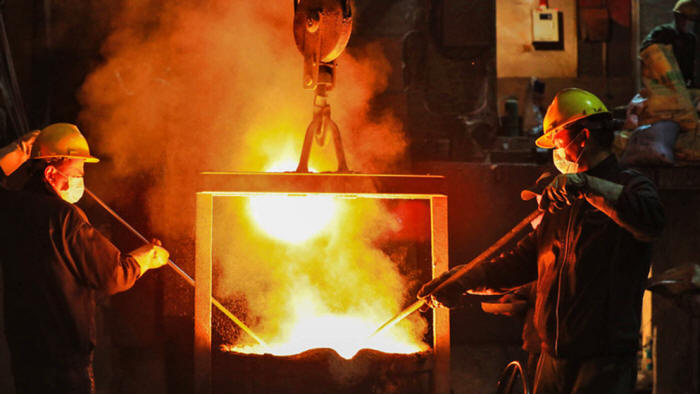|
by Dereje Yiemeru from RT Website
FILE PHOTO: Workers check molten steel from the furnace at a foundry plant in Hangzhou, Zhejiang Province of China. © Hu Jianhuan / VCG via Getty Images
make a significant contribution to crucial sectors of the world economy, and this also increases
the
group's political role...
BRICS+ collectively represents nearly half of the world's population and is set to overtake the G7 in terms of global GDP share by 2028.
The figures underscore the critical role of BRICS in the international arena, showcasing its influence over essential sectors like,
At the Kazan summit in October 2024, BRICS+ leaders invited 13 more countries to join as partners.
The new BRICS partner states which accepted the invitation are,
On January 6, 2025, Indonesia, the world's fourth most populous country, joined BRICS as a full member, making it the first Southeast Asian state to join the bloc, as well as the tenth member of BRICS...
Gross Domestic Product is,
However, if you look at the composition of the GDP in the US,
BRICS+ countries account for nearly half of global GDP in areas like food production, energy manufacturing, and public health, when measured by Parity Purchasing Power (PPP).
GDP reflects value of all the goods and services produced by countries in global terms, while GDP by PPP focuses on what money can actually buy in each country.
BRICS+ not only addresses food production but also helps stabilize global food security challenges.
By promoting sustainable agricultural practices, BRICS+ solidifies its role as the "Bread Basket of the World".
According to the International Energy Agency (IEA), global energy demand is projected to increase by 30% between 2016 and 2040.
This surge is comparable to adding the combined current energy consumption of another China and another India to the existing global demand.
Oil market management will remain the purview of
the Organization of the Petroleum Exporting Countries and
allied producers (OPEC+).
For years, OPEC+ states have complained that Western energy sanctions on Iran and Venezuela have constrained investment and export flows.
More recently, the EU embargoes on Russian
seaborne crude oil and petroleum products and the EU-G7 price caps
have created a new sanctions mechanism that is politically
weaponized, and targets a country's revenues rather than export
volumes.
Producers and consumers in this group have a
shared interest in creating mechanisms to trade commodities outside
the reach of the G7 financial sector, and this is not a small task.
For example, India's Kudankulam Nuclear Power Plant, which has been under construction with Russian assistance, features six VVER-1000 reactors that have a total capacity of 6,000 MW.
In China, four VVER-1000 reactors are operational at the Tianwan Nuclear Power Plant, with four more under construction that utilize advanced VVER-1200 reactor technology.
These new units are expected to be completed by
2028. These developments underscore the ongoing collaboration
between China and Russia in advancing nuclear energy infrastructure.
...into manufacturing processes within these
countries is revolutionizing traditional production methods,
enabling them to compete more effectively on a global scale.
This technology challenges misconceptions about
China's innovative capabilities and aims to lessen reliance on
imported iron ore, marking a significant shift in the industry.
As the world's largest steel producer and exporter, China's advancements enhance its position in the global steel market, raising concerns for domestic industries in the US and Europe.
Additionally, China's lower labor and energy costs further establish its dominance in iron and steel production.
Their contributions to the iron ore, copper, and nickel markets are substantial. In particular, the BRICS+ countries are leading producers of iron ore, with Brazil and India taking the lead.
Moreover, the BRICS+ nations collectively hold a strong position in global copper production (where Chile and Peru are key contributors).
Russia and Indonesia are prominent in nickel production, a metal that is crucial for battery manufacturing and stainless-steel production.
This highlights the strategic importance of these countries within the BRICS+ framework, especially as global interest in renewable energy solutions and electric vehicles grows.
The collaboration among BRICS+ nations in metallic ore production ensures a stable supply of critical materials and fosters advancements in technology and sustainable practices within the mining sector.
Overall,
The contribution of BRICS+ in the global economy is constantly growing, and furthermore, the sectors where the alliance holds strong positions are all crucial, from agriculture and food production to energy.
This creates a solid foundation for a steady
growth of the political role of the group while also deepening ties
among its members and partner states.
|


